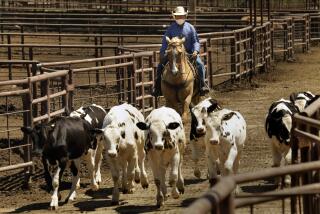Killing Animals for Food --Time for a Second Look
- Share via
At a time when many are questioning the practice of killing animals for medical purposes, it might be well to take a second look at the concept of killing and eating animals in general.
Something must be said about the dozing conscience of mankind that allows him to buzz around the meat counter without so much as a thought that this prized marbled steak was once part of a living, breathing creature. That thousands upon thousands of animals are slaughtered daily, their blood flowing equal to a huge river, to satisfy the demand for even more meat.
Where are the pickets and protesters when the chicken, being prepared for every pot, spends its entire existence in a wire cage hardly a cubic foot in dimension? When the veal calf, torn from its mother almost as soon as it is dropped, is herded into trucks and shipped trembling to its doom?
Is all this necessary? No! Flesh food is not a necessity in the human diet, as nutritionally adequate alternatives are readily available. Many people in the world thrive on a non-meat diet. Indeed, vegetarian Seventh-day Adventists in this country live an average of six years longer than their meat-eating counterparts.
The World Health Organization reminds us that meat has long been recognized as a disease-conveying agent. The prestigious National Academy of Science warns that our fat-laden, cholesterol-loaded, high protein meat diet is directly responsible for much of the heart disease and cancer that afflict so many. Studies have shown that obesity, diabetes, arthritis, multiple sclerosis and various other maladies are also involved.
Much has been published as of late of the high-powered chemicals--legal and illegal--that find their way into the feed the livestock industry uses. These include hormones, antibiotics, arsenicals, insecticides and many other unlikely substances. Some of these are known or suspected carcinogens and may cause birth defects.
At a time when people are starving to death in certain parts of the world, it should be emphasized that a steer must consume 16 pounds of grain and soy to produce one pound of meat. That grain could go directly to feed the starving. Indeed, the grain (corn, oats, barley, wheat and rye) and soybeans we feed our meat-producing animals could feed every hungry mouth in the world many times over. Cattle are competing with humans for food.
Clearly, a reassessment of the whole concept of killing and eating animals is in order.
SUZANNE SUTTON
Perris
More to Read
Sign up for Essential California
The most important California stories and recommendations in your inbox every morning.
You may occasionally receive promotional content from the Los Angeles Times.













